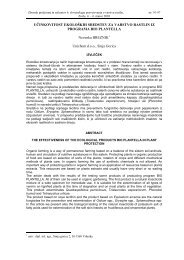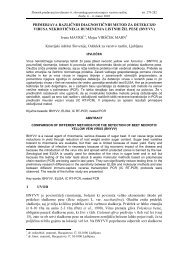Chlorantraniliprole (DPX-E2Y45, Rynaxypyr®, Coragen®) a new ...
Chlorantraniliprole (DPX-E2Y45, Rynaxypyr®, Coragen®) a new ...
Chlorantraniliprole (DPX-E2Y45, Rynaxypyr®, Coragen®) a new ...
You also want an ePaper? Increase the reach of your titles
YUMPU automatically turns print PDFs into web optimized ePapers that Google loves.
40 Andrea BASSI et al.<br />
summarizes the main product features and provides a selection of the results obtained in the<br />
experimental work carried out in the EU on codling moth, Colorado potato beetle and the<br />
European grapevine moth since 2002. The experimental results obtained in Slovenia in 2008<br />
were consistent with those from the rest of Europe.<br />
Product Features<br />
Upon exposure, the sensitive insect species rapidly stops feeding, becomes paralyzed, and<br />
ultimately die. <strong>Chlorantraniliprole</strong> is primarily active on chewing pests by ingestion and by<br />
contact, showing good ovi-larvicidal and larvicidal activity. In Colorado potato beetle, good<br />
efficacy on adults is also observed. Inhibition of insect feeding occurs rapidly (minutes to a few<br />
hours after ingestion) and death normally occurs within 24-72 hours. Consistency of performance<br />
and long lasting crop protection are key product features. Differential selectivity towards insect<br />
ryanodine receptors (RyRs) explains the product’s outstanding profile of mammalian toxicity. The<br />
remarkably low toxicity combined with low use rates provides large margins of safety for<br />
consumers and agricultural workers (Bassi et al, 2007).<br />
Common name: <strong>Chlorantraniliprole</strong><br />
Chemical class: Anthranilic diamide<br />
Code number: <strong>DPX</strong>-<strong>E2Y45</strong><br />
Molecular formula: C18H14BrCl2N5O2<br />
DuPont Reg. trademark (active) Rynaxypyr ®<br />
DuPont Reg. trademark (20 SC formulation) Coragen ®<br />
Structural formula:<br />
H<br />
N<br />
H 3 C<br />
Cl<br />
N H<br />
O<br />
H<br />
N<br />
O<br />
CH 3 N<br />
Br<br />
N<br />
N<br />
Cl<br />
Formulations - For use on codling moth, Colorado beetle and the European grapevine moth,<br />
<strong>Chlorantraniliprole</strong> is primarily formulated as a 20% w/v (200 g /l) suspension concentrate<br />
(Coragen ® ) showing good tank-stability and compatibility with conventional crop protection<br />
products. Unless otherwise specified, the results reported in this paper refer to the Coragen<br />
formulation.<br />
Beneficial organisms - <strong>Chlorantraniliprole</strong> has an excellent profile of safety to beneficial<br />
arthropods (Dinter et al. 2008), pollinators and non-target organisms such as earthworms and soil<br />
microorganisms. The product effects on honeybees have been studied extensively, demonstrating<br />
low intrinsic toxicity of chlorantraniliprole and Coragen ® . No negative effects were observed<br />
under worst-case semi-field conditions on foraging honey bees in numerous tunnel tests (Dinter et<br />
al. 2009, in press). This is an important differentiating feature of Coragen ® compared to most<br />
synthetic pyrethroid, organo-phosphate and neonicotinoid insecticides that are currently used.<br />
Earthworm acute LC50; >1000 mg a.i./kg<br />
Earthworm reproduction NOEC: 1000 mg a.i./kg<br />
Honeybee acute (48-h) LD50 (oral) : >114 µg a.i./bee<br />
Honeybee acute (48-h) LD50 (contact) >100 µg a.i./bee<br />
Wasp parasitoid (A. rhopalosiphi) LR50 and ER50 : >750 g a.i./ha<br />
Predatory mite (T. pyri) LR50 and ER50: >750 g a.i./ha





